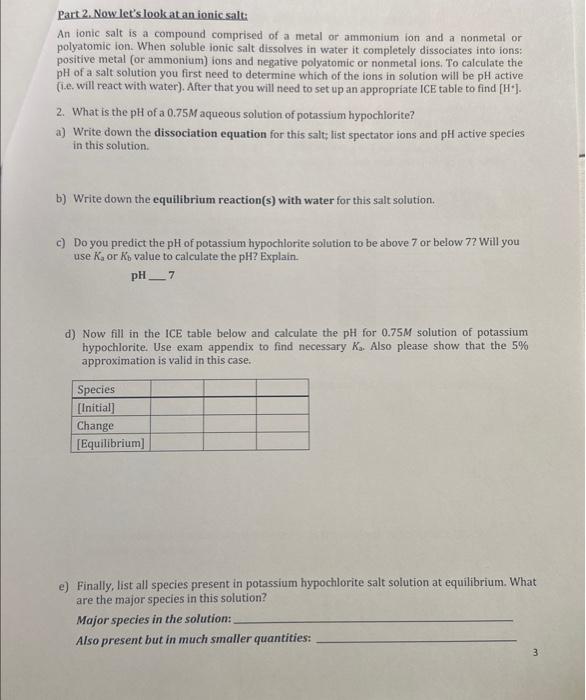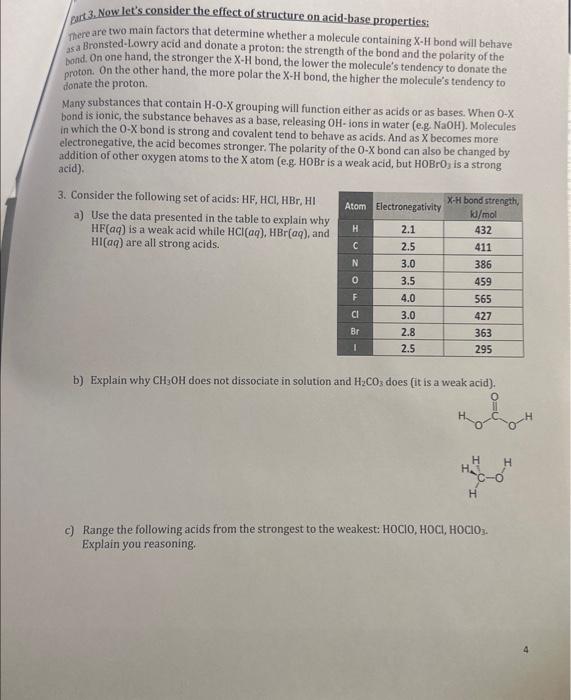were first identified as coxplore two classes of compounds known as acids and bases. Acids compounds that feel slippery asounds that taste sour while bases were first identified as acids and bases. We will spery and taste bitter. Today there are 3 prevailing theories that define Part 1. Let's consider a weak acid equilibrium: Strong acids dissociate completely in aqueous solution. This means that in solution every molecule of strong acid will lose its acidic proton. Weak acids do not completely dissociate in aqueous solution. That means that at any given moment most of the weak acid molecules will be found in solution as molecules and only a few molecules will dissociate and donate protons. Dissociation of a weak acid in aqueous solution is an equilibrium process. Every weak acid has a measured acid dissociation constant, Ka ("a" stands for acid). Like all equilibrium constants Ka tells you how far in the forwards direction the reaction (dissociation) proceeds until it reaches equilibrium. The lower the Ka value the fewer weak acid molecules will dissociate. 1. Consider a 1.00M solution of weak nitrous acid. a) Write the hydrolysis reaction that corresponds to Ka of this acid; label the acid, the base, the conjugate acid and the conjugate base. b) Now let's draw a picture that models the microscopic behavior of this acid. Draw in the box below what you expect to see on a molecular level when you study a sample of an aqueous solution of HNO2. Don't forget to label species in your diagram. Before you draw the picture discuss with your group the following questions: - Do you expect all of the acid molecules to dissociate? If not, what do you expect to see? -How do you want to model/depict molecules/ions? - Do you think you need to include any water molecules in your diagram? pH of a salt solution you first need to determine which of the ions in solution will be pH active [j.e. will react with water]. After that you will need to set up an appropriate ICE table to find [H]]. 2. What is the pH of a 0.75M aqueous solution of potassium hypochlorite? a) Write down the dissociation equation for this salt: list spectator ions and pH active species in this solution. b) Write down the equilibrium reaction(s) with water for this salt solution. c) Do you predict the pH of potassium hypochlorite solution to be above 7 or below 7 ? Will you use Ka or Kb value to calculate the pH? Explain. pH7 d) Now fill in the ICE table below and calculate the pH for 0.75M solution of potassium hypochlorite. Use exam appendix to find necessary Ka. Also please show that the 5% approximation is valid in this case. e) Finally, list all species present in potassium hypochlorite salt solution at equilibrium. What are the major species in this solution? Major species in the solution: Also present but in much smaller quantities: gurt 3. Now let's consider the effect of structure on acid-base properties: There are two main factors that determine whether a molecule containing X-H bond will behave as a Bronsted-Lowry acid and donate a proton: the strength of the bond and the polarity of the pond. On one hand, the stronger the X-H bond, the lower the molecule's tendency to donate the proton. On the other hand, the more polar the X-H bond, the higher the molecule's tendency to donate the proton. Many substances that contain HOX grouping will function either as acids or as bases. When 0X bond is ionic, the substance behaves as a base, releasing OH-ions in water (e.g. NaOH). Molecules in which the OX bond is strong and covalent tend to behave as acids. And as X becomes more electronegative, the acid becomes stronger. The polarity of the 0X bond can also be changed by addition of other oxygen atoms to the X atom (e.g. HOBr is a weak acid, but HOBrO is a strong acid). 3. Consider the following set of acids: HF,HCl,HBr,HI a) Use the data presented in the table to explain why HF(aq) is a weak acid while HCl(aq),HBr(aq), and HI (aq) are all strong acids. b) Explain why CH3OH does not dissociate in solution and H2CO3 does (it is a weak acid). c) Range the following acids from the strongest to the weakest: HOClO,HOCl1HOClO3. Explain you reasoning









